Our screenings are held at multiple venues around Chicago. This season you can find us at:
• The Music Box Theatre
3733 N Southport Ave — Directions • Parking
Tickets: $11 – $12
• The Auditorium at Northeastern Illinois University (NEIU) (inside of Building E)
3701 W Bryn Mawr Ave — Directions • Campus Map
Tickets: $10
***Complimentary Parking for audience members on Wednesday nights is available in Parking Lot D adjacent to the Bryn Mawr entrance.***
• Chicago Filmmakers
5720 N Ridge Ave., Chicago, IL 60660 — Directions • Parking
Tickets: $10
• The Gene Siskel Film Center
164 N State St — Directions • Parking
Tickets: $13
Want to attend our screenings but having financial hardships? Contact info@chicagofilmsociety.org
SEASON AT A GLANCE
☆ = Technicolor Weekend March 15-17
January ▼
Wed 1/10 at 7:30 PM
Tabu: A Story of the South Seas …………….NEIU
Tue 1/16 at 7:00 PM
Aelita, Queen of Mars ……………..Music Box
Wed 1/24 at 7:30 PM
The Woman on the Beach ……………..NEIU
Wed 1/31 at 7:30 PM
Cutter’s Way …………………NEIU
February ▼
Sun 2/4 at 7:30 PM
Joan the Woman …………..Music Box
Wed 2/7 at 7:30 PM
An American Tragedy ………………..NEIU
Wed 2/14 at 7:30 PM
Viridiana ……………………NEIU
Wed 2/21 at 7:30 PM
Kid Galahad ……………………NEIU
Mon 2/26 at 7:00 PM
Messiah of Evil …………..Music Box
March ▼
Wed 3/6 at 7:30 PM
Pumping Iron II …………….NEIU
Fri 3/15 at 6:00 PM ☆
The Boy with the Green Hair …… Gene Siskel Film Center
Fri 3/15 at 8:15 PM ☆
Cleopatra Jones …… Gene Siskel Film Center
Sat 3/16 at 2:00 PM ☆
Technicolor Shorts Program …… Gene Siskel Film Center
Sat 3/16 at 4:15 PM ☆
Has Anybody Seen My Gal …… Gene Siskel Film Center
Sat 3/16 at 7:00 PM ☆
Apocalypse Now Redux …… Gene Siskel Film Center
Sun 3/17 at 2:00 PM ☆
The Nutty Professor …… Gene Siskel Film Center
Sun 3/17 at 5:00 PM ☆
20,000 Leagues Under the Sea …… Gene Siskel Film Center
Thur 3/21 at 6:45 PM
Mission to Mars ………………..Music Box
Sun 3/24 at 11:30 AM
Humoresque …………………….Music Box
Wed 3/27 at 7:30 PM
Tokyo Pop …………….NEIU
April▼
Mon 4/1 at 7:00 PM
Seconds ………………………Music Box
Sat 4/6 at 7:00 PM
The Films of Shellie Fleming ……………..Chicago Filmmakers
Sat 4/13 at 11:30 AM
Padlocked …………………..Music Box
Sat 4/20 at 7:00 PM
Films to Dance to with Kioto Aoki ……………..CFS Office
Wed 4/24 at 7:30 PM
Tokyo Story …………….NEIU
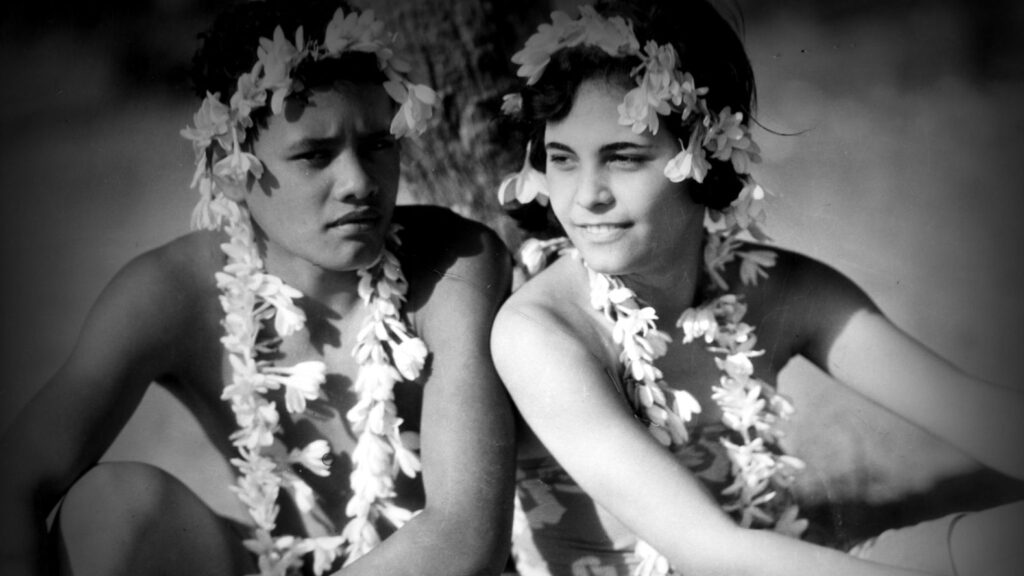
Wednesday, January 10 @ 7:30 PM / NEIU
TABU: A STORY OF THE SOUTH SEAS
Directed by F.W. Murnau • 1931
F.W. Murnau had been imported from Germany to bring an artistic air to Fox Film Corporation with Sunrise, but soon soured on the Hollywood dream factory. Robert Flaherty had never been a studio man, though his pioneering documentaries Nanook of the North and Moana played to broad and receptive audiences and demonstrated a largely untapped hunger for new approaches to storytelling. Perhaps together Murnau and Flaherty could inaugurate a new style of filmmaking and beat Hollywood at its own game. The pair sailed to Tahiti with a promise of funding from a fly-by-night film company, which never materialized. Working with a cast of non-professionals, Murnau and Flaherty pointed to an unspecified Polynesian legend as their putative source material. What they brought back from eight months in Bora Bora was something mythic but cagey, ethereal but rough: not a documentary, but a universal (and hence, very Hollywood) story of a Girl (Reri) and a Boy (Matahi) whose Paradise becomes Paradise Lost. Was it drama, anthropology, or some unholy commingling of the two? Alas, by the time the film was finished, Murnau and Flaherty had gone their separate ways, leaving cinematographer Floyd Crosby (who won an Academy Award for his efforts) as the film’s spokesman. Murnau died a week before the film’s premiere, and Tabu finally became the legend he had been after all along: a staggering vision of innocence and loss, a stark symphony guided by an otherworldly conductor. (KW)
81 min • Murnau-Flaherty Productions • 35mm from the Chicago Film Society collection at the University of Chicago Film Studies Center, permission Kino
Preceded by: “Finding His Voice” (Fleischer Studios, 1929) – 11 min – 35mm
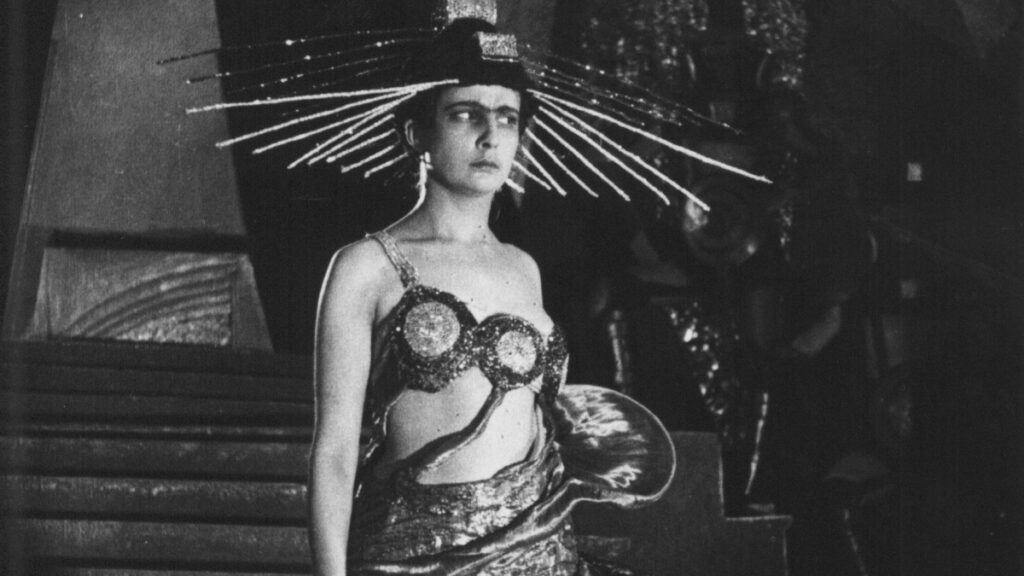
Tuesday, January 16 @ 7:00 PM / Music Box Theatre
AELITA, QUEEN OF MARS
Directed by Yakov Protazanov • 1924
A cryptic radio transmission baffles scientists and statesmen around the globe. Only the dreamy Soviet engineer Los correctly surmises that the signal is coming from Mars. With the Soviet Union mired in a period of New Economic Policy retrenchment — and Los’s wife Natasha cavorting with duplicitous aristocrats behind his back — who wouldn’t yearn to leave the Earth behind? Alas, Mars is just as backwards as the West, practically an intergalactic Barclays outpost, with the proletariat imprisoned underground while Aelita and her family pursue maximum profit. This very strange film was the product of two Russian artists who had been reluctantly brought back into the fold after periods of post-Revolutionary exile — director Yakov Protazanov had helmed dozens of Czarist-era film fossils while novelist Alexei Tolstoy had renounced his anti-Bolshevik politics and embarked on a series of science fiction epics that wed the prestige of his family name to the party line. The movie adaptation of Tolstoy’s novel was envisioned as a calling card for the Soviet film industry generally and the Mezhrabprom-Rus studio specifically, with eye-popping Constructivist-Martian costumes from Alexandra Exter and sets from Viktor Kozlovsky. Alas, this popular success was viciously mocked in the increasingly strident Soviet press. Director Lev Kuleshov dismissed Aelita as “the blind alley of pre-revolutionary cinema” while critic Vladimir Blyum lamented it as an exemplar of a trend where “it even became de rigueur to spice agitational pictures with a romantic subplot, far-fetched stunts, and happy endings …. Agitation steeped in stupidity began to merge into counter-agitation.” (KW)
110 min • Mezhrabprom-Rus • 35mm from the Walker Art Center’s Ruben/Bentson Moving Image Collection
Preceded by: “Trip to Mars” (Fleischer Studios, 1924) – 7 min – 16mm
Live musical accompaniment by Maxx McGathey!
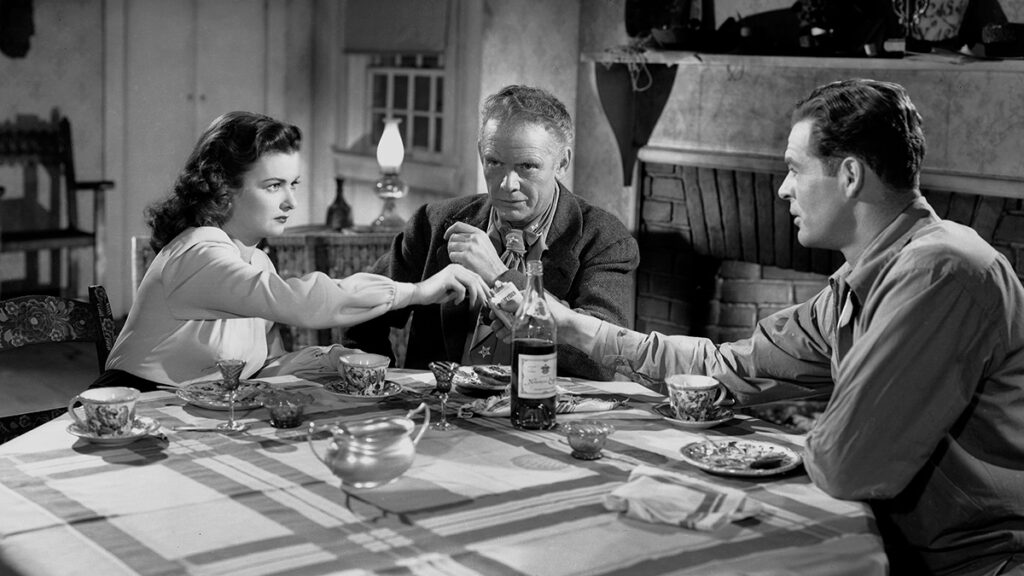
Wednesday, January 24 @ 7:30 PM / NEIU
THE WOMAN ON THE BEACH
Directed by Jean Renoir • 1947
Joan Bennett’s face is illuminated by flames in the hallucinatory nightmares of a Coast Guard officer with PTSD in Jean Renoir’s wild, visually ravishing, and atmospheric melodrama. An adaptation of a reasonably popular 1945 novel that might have been straightforward in other hands, The Woman on the Beach turned out to be the idiosyncratic coda to Renoir’s wartime stint in Hollywood. The shoot was marked by the abrupt departure of producer Val Lewton, after which RKO left Renoir to helm the largely unscripted and freewheeling production. The lack of studio encroachment allowed Renoir to execute a long-simmering vision: “a film based on what we call today sex…. a love story based purely on physical attraction, a story in which emotions played no part.” After a disastrous preview screening, a discouraged Renoir was forced to heavily reshoot and reedit the movie. “You know, a preview is a horrible test. You sit in a theater, and it’s as if someone were stabbing you with knives all over your body,” Renoir recalled. The film’s choppy 71-minute final cut has a fractured feel, like the feverish dreams of its protagonist. Robert Ryan stars as the troubled Lieutenant, who resides in a small seaside town. He has a sweet blonde girlfriend—that is, until on a deserted beach, he comes across Peggy (Joan Bennett), a brunette stunner married to Tod, a blind painter (Charles Bickford). Peggy and Tod’s marriage is itself a nightmare, complete with drunken fights, violence, and bitter allegations. All three corners of this love triangle are loose cannons. What anyone wants, other than chaos, remains a mystery. Would any of them choose happiness? Probably not on purpose. Lucky for us! Restored by the Library of Congress and The Film Foundation. Funding provided by the Hobson/Lucas Family Foundation. (RIN)
71 min • RKO Radio Pictures • 35mm from Library of Congress
Preceded by: Schlitz Playhouse: “Bitter Parting” (Paul Henreid & James Neilson, 1957) – 30 min – 35mm
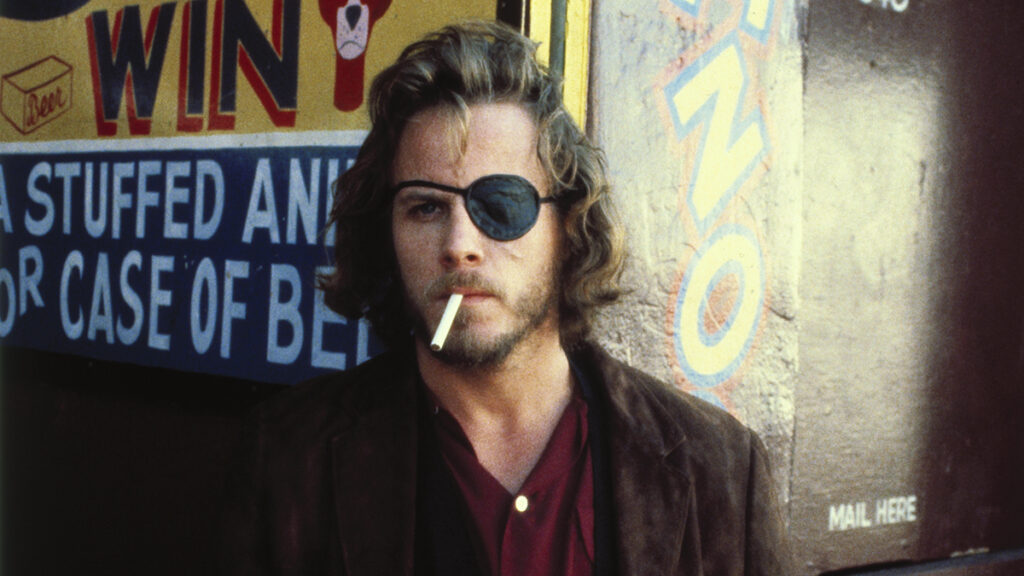
Wednesday, January 31 @ 7:30 PM / NEIU
CUTTER’S WAY
Directed by Ivan Passer • 1981
Overeducated gigolo Richard Bone (Jeff Bridges) spends his days tooling around Santa Barbara, half-heartedly hawking yachts to the polo set and hanging out with his washout buddies, who all share the bruised affect of Weather Underground comrades keeping their heads down in the straight world. Bone’s best friend Alex Cutter (John Heard) is a real piece of work: a one-eyed, one-armed, one-legged Vietnam veteran with a chip on his shoulder and an inexhaustible array of paranoid schemes on his mind. (“I haven’t even begun to let my imagination loose on this one,” Cutter says of one nascent conspiracy theory, as if flinging open the doors to his artist’s studio.) By contrast, Cutter’s wife Mo (Lisa Eichhorn, staggering) sees the world so clearly that she can only bear to get through the day in an alcoholic stupor, fleetingly enlivened by fantasies of boning Rich Bone. What could shake them all loose? How about a dead girl stuffed in a trash can, probably the handiwork of the local oil magnate who owns half the town, routinely orders assassinations, and may as well stand in for the shadowy forces responsible for US military adventures in Vietnam? Soon enough Cutter and Bone are sleepwalking into a hand-crafted extortion scheme to smoke out the killer. Less a taut who-done-it thriller than a stoner’s hazy who-done-what-again contraption, Cutter’s Way nails the aimless amble of a Santa Barbara afternoon and the hopeless vibe of the early Reagan era. Czech director Ivan Passer’s all-American fever dream was fumbled by United Artists and pulled from theaters after a week — probably some kind of coverup. (KW)
109 min • United Artists Classics • 35mm from Park Circus
Preceded by: “Uncommon Valor” (Kendrick W. Williams, 1955) – 10 min – 35mm
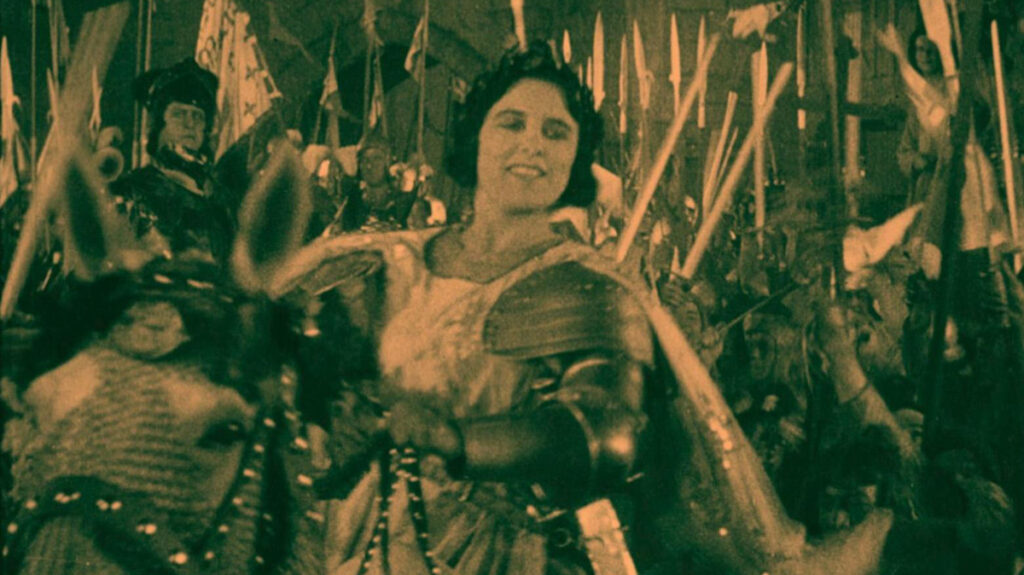
Sunday, February 4 @ 7:30 PM / Music Box Theatre
JOAN THE WOMAN
Directed by Cecil B. DeMille • 1916
Before his name became synonymous with the Biblical epic, Cecil B. DeMille experimented with several different modes of historical storytelling, with sex, spectacle, and narrative ingenuity punching up the textbook facts. His first such effort, Joan the Woman, wrapped the story of the Maid of Orleans within a framing story about the imperative of French and British cooperation in the trenches of World War I. Metropolitan Opera soprano Geraldine Farrar stars as Joan of Arc, who dons armor, exposes the innate weaknesses of patriarchy, and faces off against her ex-boyfriend (Wallace Reid) in battle after recognizing the futility of romance. A fractured feminist interpretation that simultaneously damns and exults traditional gender roles, Joan the Woman is nothing if not a film of its anxious moment. Though it does not shy away from depicting Joan’s divine visions, DeMille and scenarist Jeanie Macpherson routinely emphasize the fragility of flesh over chapter-and-verse, with a pair of elaborate battle sequences. “It is impossible to describe in detail what producer DeMille has accomplished with such a wealth of material,” effused Variety. “Suffice it to say that no one else could have done more and few, if any, could have done as much.” Long available only in substandard copies, this new restoration, derived from DeMille’s personal nitrate print, retains the elaborating tinting, toning, and Handschiegl hand-colored effects that haven’t been seen in their expressive glory in over a century. Restored by the George Eastman Museum with funding from the Century Arts Foundation. (KW)
148 min • Cardinal Film Corporation • 35mm from George Eastman Museum
Preceded by: “The Pillar of Fire” (George Méliès, 1899) – 1 min – 35mm
Live musical accompaniment by Jay Warren!
This film will have a short intermission.
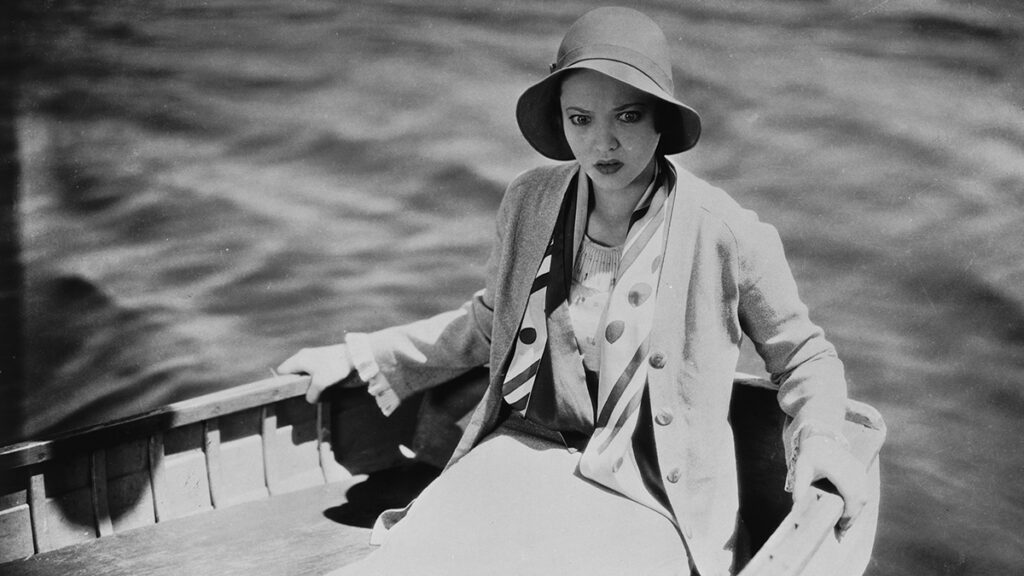
Wednesday, February 7 @ 7:30 PM / NEIU
AN AMERICAN TRAGEDY
Directed by Josef von Sternberg • 1931
An American Tragedy was the first adaptation of author Theodore Dreiser’s 1925 900-page behemoth. It was a fictionalized account of a famous crime that had captured the nation, the 1906 murder of Grace Brown, aged twenty, by her lover Chester Gillette, a fellow employee at his wealthy uncle’s factory. The film has become relatively obscure, lost in the shadow of the novel’s second adaptation, 1951’s classic A Place in the Sun. It came on the heels of von Sternberg’s string of successful collaborations with Marlene Dietrich, including Dietrich’s breakthrough, 1930’s The Blue Angel. Morocco followed, while 1931 marked the releases of Dishonored— and An American Tragedy. It was a change of pace for von Sternberg, one of cinema’s great aesthetes. Gone were the gowns, feathers, and glamour; this movie never could have starred Dietrich. The film had a sensational (and rather insensitive) tagline (“The Story of a Girl….Good Enough to Betray…But Not Good Enough to Marry”). Part tragedy, part courtroom drama, the film follows unscrupulous striver Clyde Griffiths (an impenetrable Phillips Holmes), who flees after his involvement in a hit and run. Clyde is given a position of power and immediately exploits it, pursuing his employee Roberta (portrayed by the luminous Sylvia Sidney) for less than honorable reasons. Her continued existence begins to inconvenience him after he’s introduced to a beautiful heiress—especially after Roberta becomes pregnant. Von Sternberg’s An American Tragedy is not particularly interested in class, in sharp contrast to Dreiser’s novel; it is primarily concerned with the soul, with the torment and tragedy of losing one’s humanity. (RIN)
96 min • Paramount Pictures • 35mm from Universal
Preceded by: “The Runt Page” (Ray Nazarro, 1932) – 10 min – 35mm
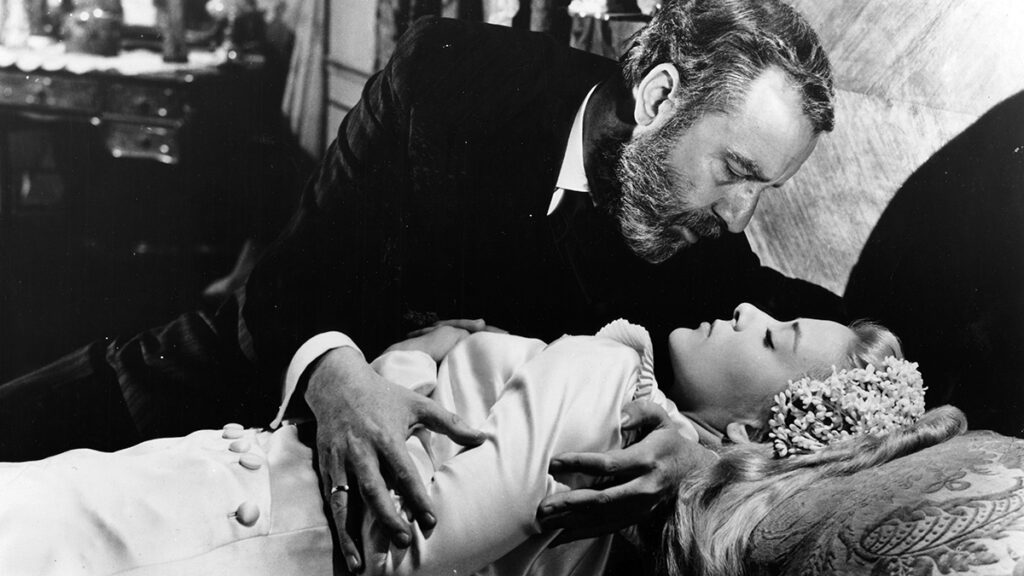
Wednesday, February 14 at 7:30 PM @ NEIU
VIRIDIANA
Directed by Luis Buñuel • 1961
In Spanish with English subtitles
Narcissism or charity? Before taking her vows, a gorgeous and devout nun-in-training Viridiana (Silvia Pinal) is sent to visit her widowed uncle Don Jaime (Fernando Rey), a wealthy benefactor with a not-so-hidden agenda. Premiering three years after the release of Hitchcock’s Vertigo, Viridiana begins as another movie about a man who attempts to perversely recreate a dead blonde. Don Jaime plots with his house servant Ramona (Margarita Lozano) to entrap his niece and violently prevent her from taking her vows, even adorning Viridiana in the wedding gown and veil of her look alike aunt. Eventually the would-be nun turns heiress and welcomes a crew of beggars to the mansion, to the dismay of her illegitimate cousin Jorge (Francisco Rabal). Buñuel shuffles the deck on some of his most prevalent themes and motifs with Viridiana, a satirical comedy that skewers Catholicism while reveling in fetishism and taboo-breaking subversion. Buñuel, a cinematic troublemaker, is the only person who could have made the film, a rigorously composed 90 minutes of shocking imagery and events, including a joyously sacrilegious depiction of the Last Supper. The film marked Buñuel’s return to his native country after over two decades of international work in the United States, Mexico, and France. Viridiana’s reception led to both the 1961 Palme d’Or and a disavowal from the Spanish government. Following controversy that declared the film blasphemous, it was blocked from release in Spain until Francisco Franco’s death in 1977. However, not all controversy is bad—to Buñuel’s delight, censorship even directly contributed to the film’s famously suggestive ending, a winking nod at further depravity. (RIN)
91 min • Unión Industrial Cinematográfica (UNINCI) • 35mm from Janus Films
Preceded by: The Sound of Music Trailer (1965) – 35mm
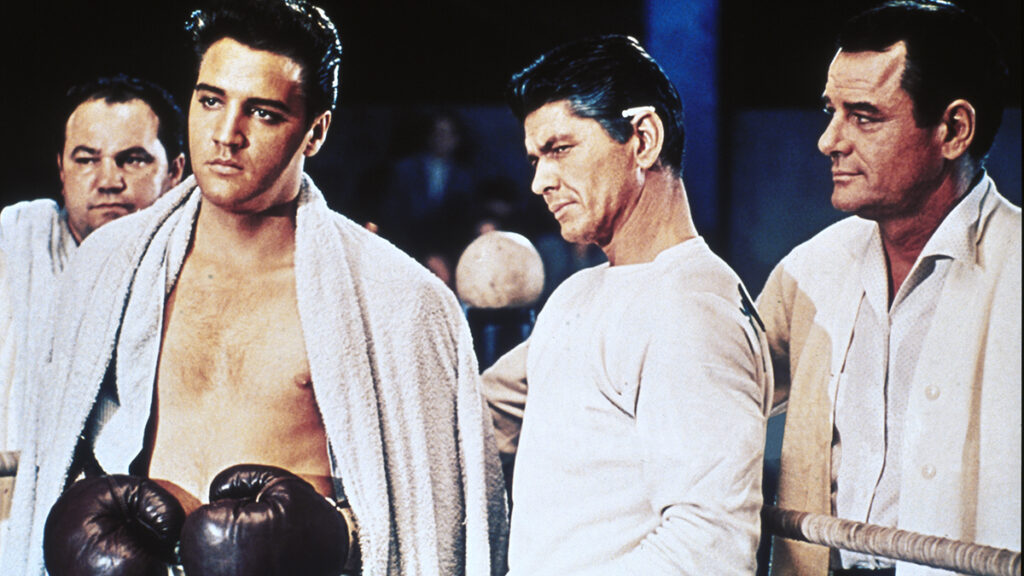
Wednesday, February 21 at 7:30 PM @ NEIU
KID GALAHAD
Directed by Phil Karlson • 1962
Welcome to Grogan’s Gaelic Gardens resort in picturesque Cream Valley, New York, home to sleazy part-time boxing promoter and full-time gambler Willy Grogan and his long-suffering “fiancée” (depending on whether you ask him or her). When a young GI played by Elvis Presley literally falls off the back of a truck into town, it doesn’t take long for Grogan to find out he’s not too bad with the gloves, or at least seems to have an extremely hard skull. The velvet-voiced newcomer begins training under Lew (a solid performance by Charles Bronson, who may look better in jeans and a sweatshirt than any man alive) in preparation for a big fight that promises to solve Willy’s money problems. Presley sings, he dances, he gets punched in the face! A lot. It was his sixth film in less than two years, so he may not have noticed. He also gets cozy with Willy’s sister, an Audrey Horne look-alike played by Joan Blackman, who receives the brunt of his ballads. Kid Galahad had behind-the-scenes assistance from real-life former light welterweight champion Mushy Callahan (“I’m having an awful time with Elvis because he looks too GOOD”) and was helmed by talented director (and Chicago native) Phil Karlson, of Kansas City Confidential and Gunman’s Walk fame. While Southern California is about as convincing at playing the Catskills as Elvis is at playing a boxer, if you let the Hollywood magic do its work you’ll be rewarded with a spirited romance filmed on location in stunning timber-chic Idyllwild, CA, a whole lot of angelic crooning, and numerous scenes of Elvis in shorts. So basically, your money’s worth. (RL)
96 min • United Artists • 35mm from Park Circus
Preceded by: Elvis trailer reel – 10 min – 35mm
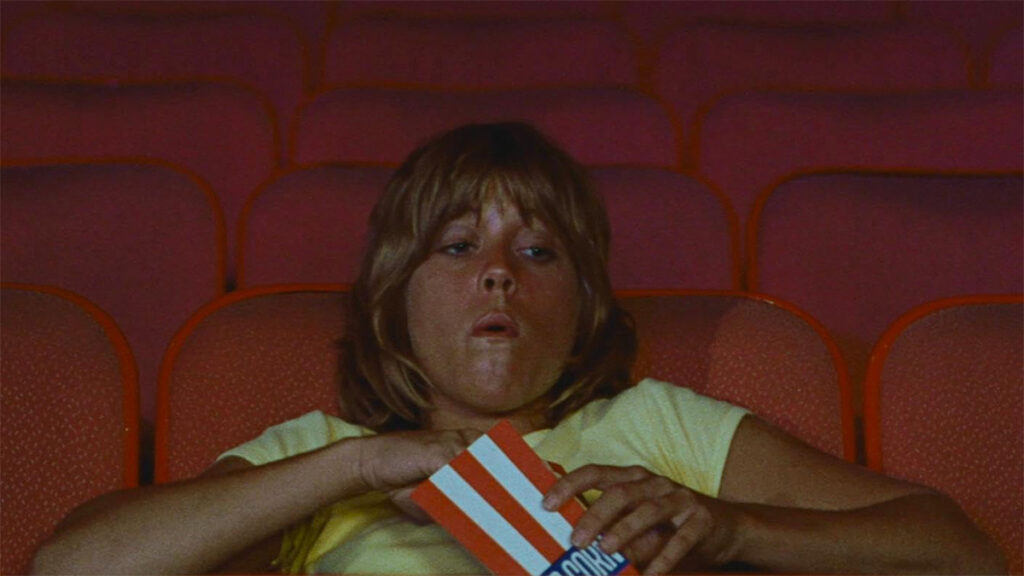
Monday, February 26 @ 7:00 PM / Music Box Theatre
MESSIAH OF EVIL
Directed by Willard Huyck & Gloria Katz • 1974
A man collapses in exhaustion in a stranger’s backyard, believing himself saved until a smiling adolescent girl affectionately dries the sweat from his forehead before slitting his throat. A young woman catches a ride with an imposing albino man who eats a live rat in front of her, and offers to share the next one if she’s hungry. A painter of psychotronic murals goes missing after sending his daughter a series of paranoid letters. When she goes looking for him, all she finds in his place is a thick haze of dread and madness rolling over the Pacific Coast. Among the writers and directors to forge industry careers in the New Hollywood of the 1970s, Willard Huyck and Gloria Katz accumulated perhaps the most fascinating and inscrutable filmography of all of their peers. The pair served as script doctors on Star Wars, wrote Indiana Jones and the Temple of Doom, and split directing and producing duties for a number of their own screenplays, a practice which ended with the release of Howard the Duck in 1986. Concurrent with Huyck and Katz’s first major screen credit (writing the treatment for George Lucas’s American Graffiti), the two made a film for the regional horror market worlds away from the smooth-finish film cultural behemoths that bear their names. Featuring contributions from art director Jack Fisk (best known for his work with Terrence Malick and David Lynch) and experimental filmmaker Morgan Fisher, Messiah of Evil has remained a pedigreed singularity in American cinema, drifting between unaccountably menacing encounters and episodes of present, incomprehensible horror with its own somnambulist logic, and leaving significant mysteries unresolved by its end. Half a century from its genesis, it remains unshakeable, a vision of hell forming in one of the dim sprawls of asphalt that stretches between destinations in America. (CW)
90 min • International Cine Film Corporation • 35mm from American Genre Film Archive
Preceded by: “Outer Space” (Peter Tscherkassky, 1999) – 10 min – 35mm from Canyon Cinema
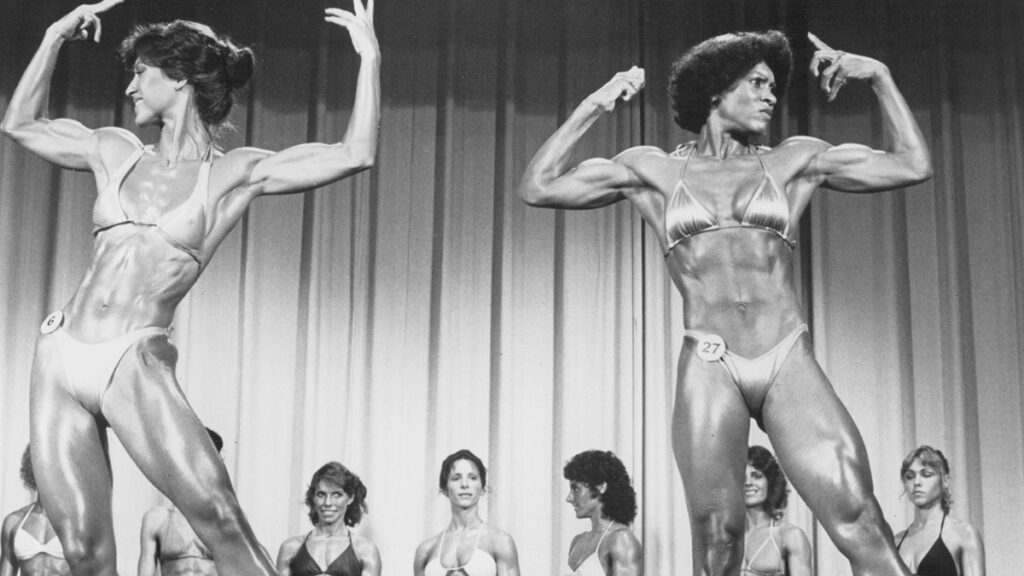
Wednesday, March 6th @ 7:30 / NEIU
PUMPING IRON II: THE WOMEN
Directed by George Butler • 1985
“I happen to believe in bodybuilding, and I hold the belief that you can create a very feminine shape through bodybuilding.” Pumping Iron II: The Women emerged from the monumental success of its predecessor, Pumping Iron — the documentary that thrust Arnold Schwarzenegger into stardom and triumphantly validated bodybuilding as a serious sport. We follow three competitors: Carla Dunlap, synchronized swimmer-turned-bodybuilder; Rachel McLish, a former Ms. Olympia Champion, who’s gunning for the first-place prize money so her lover, Randy, can end his career as a male stripper; and then there’s Bev Francis from Melbourne, daydreaming about the allure of strength. Bev, a former ballet dancer and powerlifter who already holds the title of the most muscular woman in the world, is now entering bodybuilding, making her U.S. competition sweat with her physique and endurance. Carla, Rachel, and Bev face off in the bodybuilding competition Caesar’s World Cup 1983 (constructed for the sole purpose of this film) at Caesar’s Palace in Las Vegas. The women bodybuilders in the film are praised for their athleticism by their peers and trainers but are antagonized by their male counterparts for challenging what femininity can look like. Contra Sports Illustrated, which casually asserted that the stars of Pumping Iron II were grotesque and strange, the women in competition – lifting weights in a full face of makeup with bustling muscles and stunning leotards – demonstrate that their physiques do not diminish their femininity. (TV)
107 min • White Mountain Films • 35mm from University of North Carolina School of the Arts, permission White Mountain Films
Preceded by: “Catherine Deneuve Chanel Commercial Reel” – 5 min – 35mm

☆ = Technicolor Weekend Screening
March 15th – 17th at the Gene Siskel Film Center, we present six features and a program of short subjects in beautiful, vintage Technicolor prints.
Not to be confused with the 3-strip Technicolor filming process (abandoned in 1955), the Technicolor printing process involved transferring yellow, cyan, and magenta dyes one by one onto the film base to create the release prints shown in theaters, in a process analogous to offset printing. Prints produced using this method were known for their deep, saturated colors, and the resulting “look” is effectively impossible to replicate using 2024’s digital or analog technologies.
Technicolor prints also have the archival benefit of extraordinary color stability. While the colors in an original print on Eastman stock (the leading Technicolor competitor in the ’50s-’70s) would be completely faded to pink today, prints on Technicolor stock have color just as rich as the day they were released.
Although Technicolor printing ended in the US around 1974, the process was so beloved that it was very briefly revived from 1996 to 2001 (at incredible expense), during which time a handful of large studio titles, including Apocalypse Now Redux, screening in this series, were printed. The process was retired permanently when Technicolor was bought by the British media company Carlton Communications, rendering every surviving Technicolor print completely irreplaceable.
All of the films screening in this series show in prints that were at one point or another saved by private collectors. They were intended to last only through their initial runs, but instead have endured hundreds of projections, studio mergers, film exchange closures, and multiple private owners. These unlikely survivors offer us a view of what these films looked like before digital color correction and other modern restoration techniques, and are stunning examples of an incredibly complex industrial process that delighted millions.
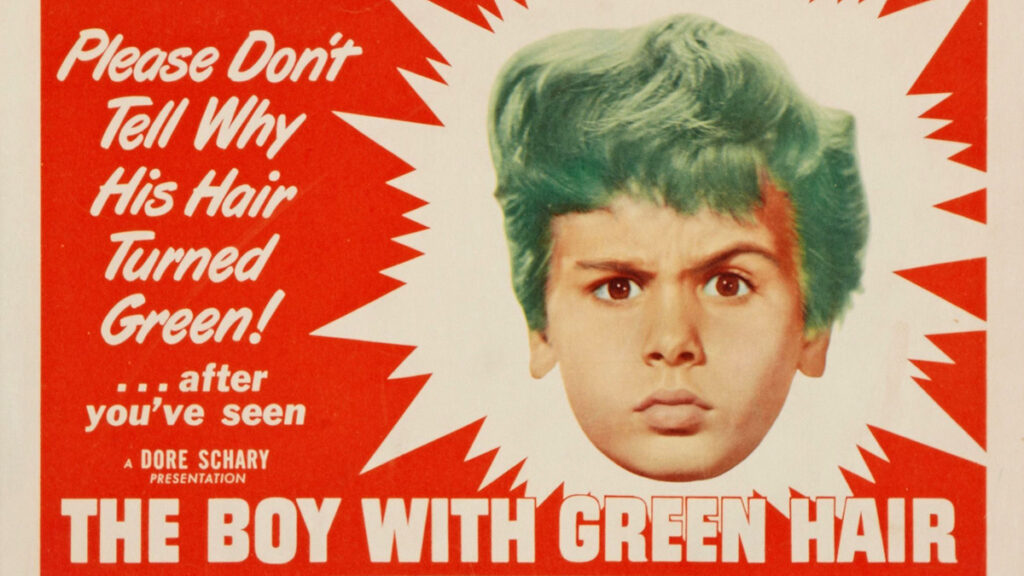
Friday, March 15th @ 6:00 PM
THE BOY WITH GREEN HAIR ☆
Directed by Joseph Losey • 1948
In Joseph Losey’s weird, gorgeous Technicolor fantasy, a neglected war orphan and possible messiah shares the miraculous story behind his green-colored hair (as well as his subsequent persecution) with a psychologist after being discovered bald-headed and alone. Shot in the aftermath of the Second World War, the odd and ambitious film is many things: an allegory on discrimination, an anti-war protest, an appeal for tolerance, and a treat for the eyes. It was also a box office flop, and an expensive one at that. A few years later, Losey was blacklisted from Hollywood after refusing to testify before the HUAC, relocating to England to continue his directorial career. Original Technicolor prints were nitrate; we will be screening an IB Technicolor safety reissue print avec sous-titres français. (RIN)
82 min • RKO Radio Pictures • 35mm from private collections, permission Warner Bros.
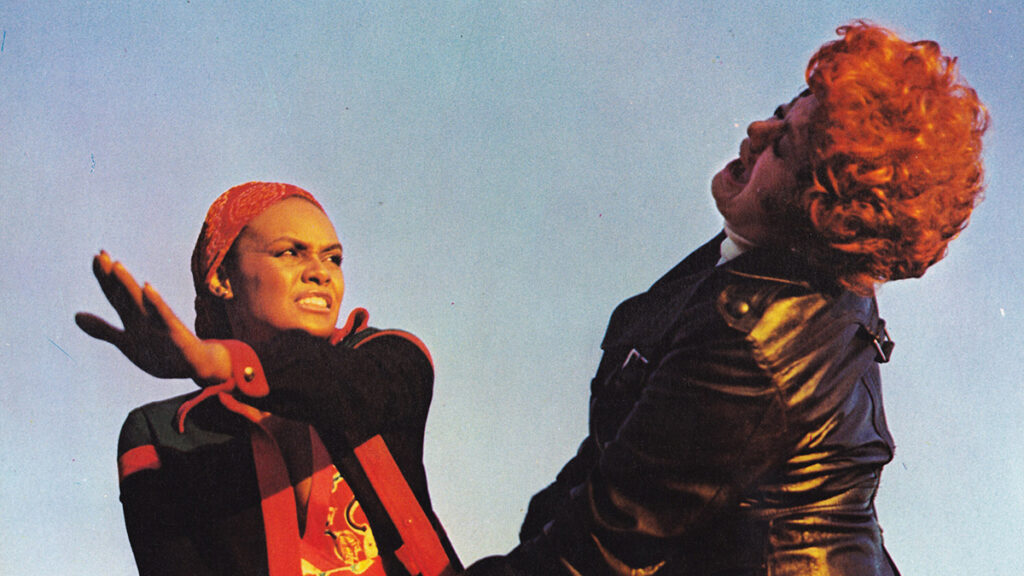
Friday, March 15th @ 8:15 PM
CLEOPATRA JONES ☆
Directed by Jack Starrett • 1973
Fur bomber jackets, blue skies, and burning poppy fields; such are the sights of Cleopatra Jones, a 1973 American blaxploitation classic starring Tamara Dobson as the titular 6’2″ supermodel and undercover special agent. Kung-fu master Cleopatra “Cleo” Jones works for the government out of her tricked-out ‘73 Stingray. In order to defend her community, Cleo takes on a cartel run by a drug lord known as Mommy (a delightfully unhinged Shelley Winters). She faces off against Mommy’s hitmen, as well as a corrupt police force that interferes with her lover’s passion project, a halfway house serving addicts. As entertaining as it is eye-catching, Jones is a can’t-miss Technicolor spectacle. (RIN)
89 min • Warner Bros. • 35mm from private collections, permission Warner Bros.

Saturday, March 16th @ 2:00 PM
TECHNICOLOR SHORTS PROGRAM ☆
The Voice Beneath the Sea, a documentary about the laying of the first transatlantic telephone line. McQ: A Digest, a “found footage” clip reel which condenses the John Wayne film McQ to 15 minutes and cuts between Technicolor and Eastman film stocks. Scenes from an underwater premiere of our favorite Don Knotts movie in Weekend at Weeki Wachee. These delights and many more cartoons, trailers, and oddities await you in our Technicolor Shorts Showcase, which represents the strange and gooey fruits of 12 years of CFS film collecting. (JA)
Approx 90 minutes • 35mm from Chicago Film Society
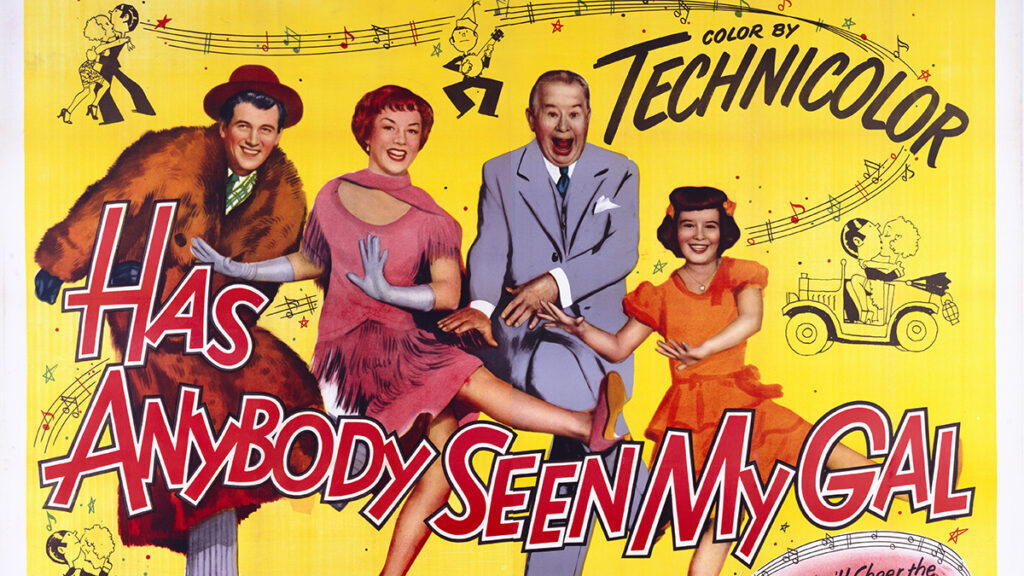
Saturday, March 16th @ 4:15 PM
HAS ANYBODY SEEN MY GAL ☆
Directed by Douglas Sirk • 1952
Looking back on his life with regret, the childless old goat millionaire Charles Coburn anonymously gives $100,000 to the family of his only true love. Masquerading as a surrealist painter in need of a room, Coburn visits his new family to make sure they spend the money wisely, and finds them abusing it to mostly tragic effect: gambling, bad stock tips, bad engagements, dumb poodles, and parties with multiple Santa Clauses. Set in small town Vermont in pre-Depression 1928, Has Anybody Seen My Gal is part of Douglas Sirk’s underappreciated series of Americana musicals, which like his melodramas embrace the delicious hues of American excess while exposing its rotten core. Featuring the first of many legendary collaborations between Sirk and Rock Hudson, Has Anybody Seen My Gal screens in the only known 35mm print in the country. (JA)
89 min • Universal-International • 35mm from Chicago Film Society, permission Universal
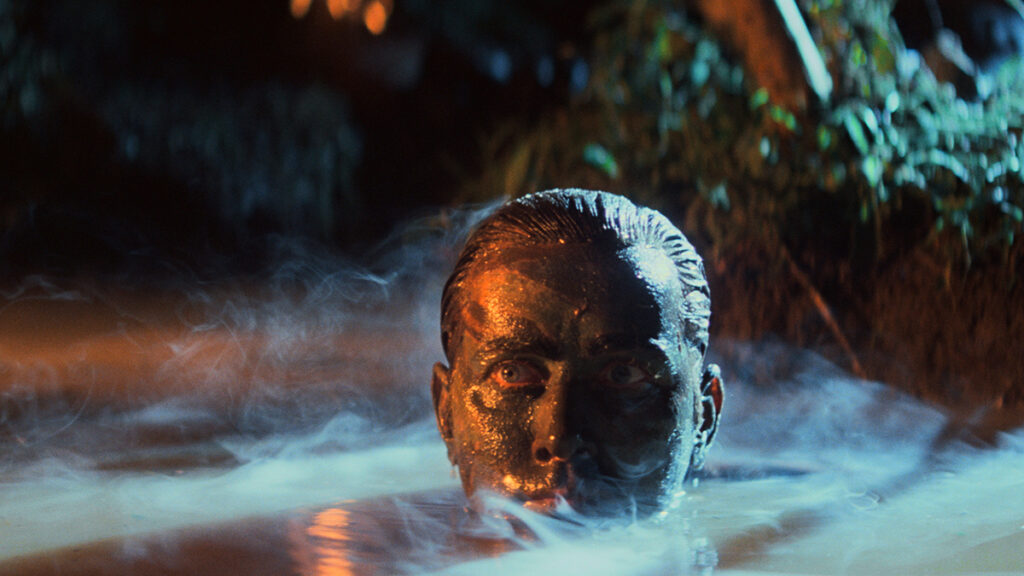
Saturday, March 16th @ 7:00 PM
APOCALYPSE NOW REDUX ☆
Directed by Francis Ford Coppola • 1979
The 2001 extended version of the Vietnam War drama added 49 minutes to the 1979 theatrical cut. The dramatic restructuring of one of the most iconic American movies of all time was likely not much of a concern to Coppola, who has never been shy about a recut. It is one of three versions from the famously scissor-friendly director. Original 35mm (and 70mm!) prints of Apocalypse Now in 1979 were Eastmancolor, but the brief resurgence of IB Technicolor in the late 1990s allowed cinematographer Vittorio Storaro’s expressive palette to reach its apotheosis in Redux. Editor Walter Murch reluctantly agreed to return to Vietnam and recut the original camera negative to conform to the Redux continuity. Coppola insisted that this would be the definitive version of the film. The latest version, Apocalypse Now Final Cut, was released in 2019. (RIN)
202 min • American Zoetrope • 35mm from private collections, permission Rialto

Sunday, March 17th @ 2:00 PM
THE NUTTY PROFESSOR ☆
Directed by Jerry Lewis • 1963
In perhaps the most enduring hit of his career, Jerry Lewis stars as Julius Kelp, a neuroses-riddled chemistry professor who has run afoul of both his university’s administration and its student athletes, who mercilessly humiliate him in front of the attractive young women he teaches. Kelp’s scientific prowess leads him to a solution, a serum which transforms him into debonair nightclub performer and all-around jerkoff Buddy Love. The bold and generously applied colors Lewis favored as a visual stylist were a perfect fit for the Technicolor process, which perhaps reached its apotheosis in the toxic green chemicals and chintzy purple night club decor littered throughout The Nutty Professor. It’s this uniquely striking palette that gives some clarity to what Jean-Luc Godard meant when he said of Lewis: “he’s more a painter, maybe, than a director.” (CW)
103 min • Paramount Pictures • 35mm from private collections, permission Paramount
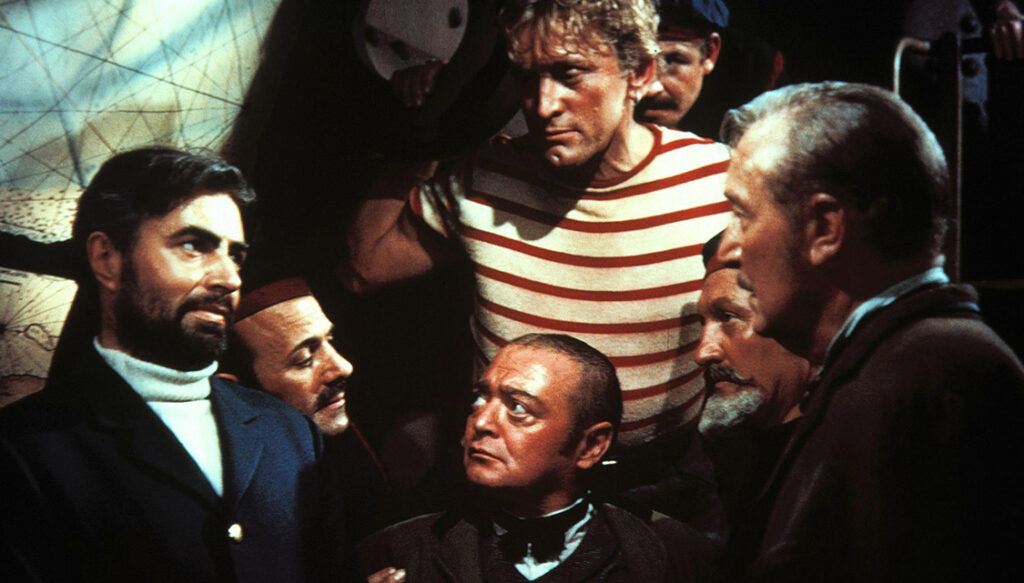
Sunday, March 17th @ 5:00 PM
20,000 LEAGUES UNDER THE SEA ☆
Directed by Richard Fleischer • 1954
Ending a decades long Swift/Perry-sized feud, Walt Disney brought in Richard Fleischer, son of Betty Boop creator Max Fleischer, to direct this story of male ego and hubris. Disney’s first major attempt at serious live action filmmaking brought in a crew of A-list actors–a singing Kirk Douglas, Paul Lukas, Peter Lorre, and a particularly dark and brooding James Mason–and was, at the time of release, among the most expensive films ever made. Much of the cost came from the experimental underwater cinematography, which required custom-built diving suits and air tanks that only allowed for a few minutes of filming at a time. A one-ton, life-sided giant squid operated by a crew of 30 people also had to be redesigned multiple times at enormous expense. The results are, of course, spectacular, testing the limits of practical effects to create a world just as astonishing as in Disney’s animated features. (JA)
127 min • Walt Disney Productions • 35mm from the Chicago Film Society collection at the University of Chicago Film Studies Center, permission Disney

Thursday, March 21st @ 6:45 PM / Music Box Theatre
MISSION TO MARS
Directed by Brian De Palma • 2000
In 1975, Disneyland opened Mission to Mars, a cost-conscious update of their Flight to the Moon attraction, which simulated interplanetary travel using vibrating seats and multiple 16mm projectors. It closed in 1992, and was eventually replaced by Redd Rockett’s Pizza Port. Eight years after its closure, Mission to Mars would enjoy the distinction of being the first Disneyland ride to receive a theatrical film adaptation (preceding The Country Bears, Pirates of the Caribbean, and two different iterations of The Haunted Mansion). If Mission to Mars the attraction was a thrifty repurposing of a Disney holding past its prime, its movie adaptation, an all-ages tentpole budgeted at $100 million and helmed by Scarface and Dressed to Kill director Brian De Palma, was anything but. It’s the year 2020 and the first manned expedition to Mars has successfully landed on the planet’s surface, an unforgivingly hostile landscape that summarily terminates the entire crew, save commander Luke Graham (Don Cheadle). Luke’s best friend Jim McConnell (Gary Sinise), a classic space melodrama hero with a dead wife to make proud, charges ahead on an equally disastrous rescue mission which will kill more of his friends and end with the secrets of the cosmos revealed to the bedraggled survivors. Upon release, Mission to Mars ran afoul of mainstream American critics affronted by its undiluted sentimentality and genial space woo-woo, their dismissals stoking full-throated defenses from Cahiers du Cinéma (who placed it in their top ten of the year alongside films by Chantal Akerman and Edward Yang) and assorted De Palma auteurists for whom the film’s excellence was inextricable from its director’s formal trademarks. Featuring a stately and lush score from frequent De Palma collaborator Ennio Morricone. (CW)
114 min • Touchstone Pictures • 35mm from The Walt Disney Company
Preceded by: “Our Lady of the Sphere” (Lawrence Jordan, 1969) – 10 min – 35mm from Canyon Cinema
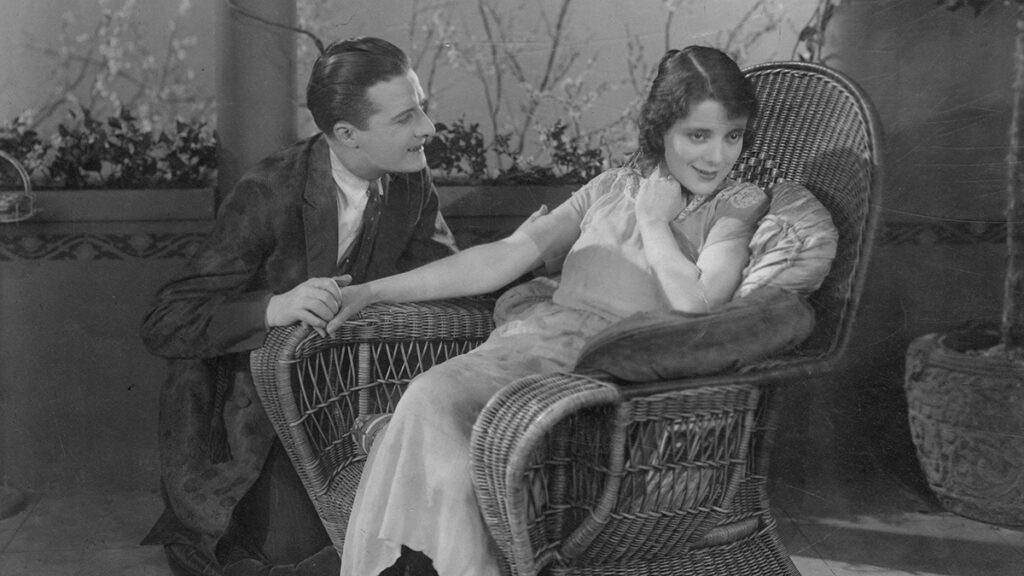
Sunday, March 24 @ 11:30am / Music Box Theatre
HUMORESQUE
Directed by Frank Borzage • 1920
Publishing magnate William Randolph Hearst founded Cosmopolitan Productions to boost the screen career of his mistress Marion Davies, but the studio found its first major critical and commercial success with Humoresque, a heart-tugging drama about a Jewish family with no role for comedienne Davies. (The film was adapted by Frances Marion from a Fannie Hurst story that first ran in Hearst’s Cosmopolitan Magazine, so corporate efficiency won out regardless.) Set in New York’s Lower East Side ghetto, where kids wrestle on the sidewalk for used cigarette butts and junkmen peddle dubious antiques, Humoresque follows the Kantors, a Russian émigré family dominated by the original Yiddishe Momme (Vera Gordon, a stage actress from Yekaterinoslav) who dotes on her son Leon. He grows up and becomes an acclaimed violinist (Gaston Glass) whose talent serves as a ticket to upward mobility for the Kantor clan — until World War I interrupts the march of assimilation. (“When there is talk in the press of Jewish radicals and bolshevists,” observed Educational Film Magazine, “it is good to see a strong photoplay featuring the patriotism of a Jewish youth in whose grasp was fame and fortune but who deliberately gave it all up to fight for his Uncle Sam.”) Voted the best film of 1920 by readers of Photoplay, Humoresque announced Frank Borzage as a master of urban melodrama and launched a legion of sentimental imitators. The film was loosely remade in 1946, with the violinist’s shiksa girlfriend Joan Crawford taking top billing and engineering an over-the-top exit scored to Tristan and Isolde, but it’s the original that leaves us verklempt. (KW)
75 min • Cosmopolitan Productions • 35mm from UCLA Film & Television Archive
Preceded by: “The Boy Friend” (Fred Guiol, 1928) – 20 min – 35mm from UCLA Film & Television Archive
Live musical accompaniment by David Drazin!
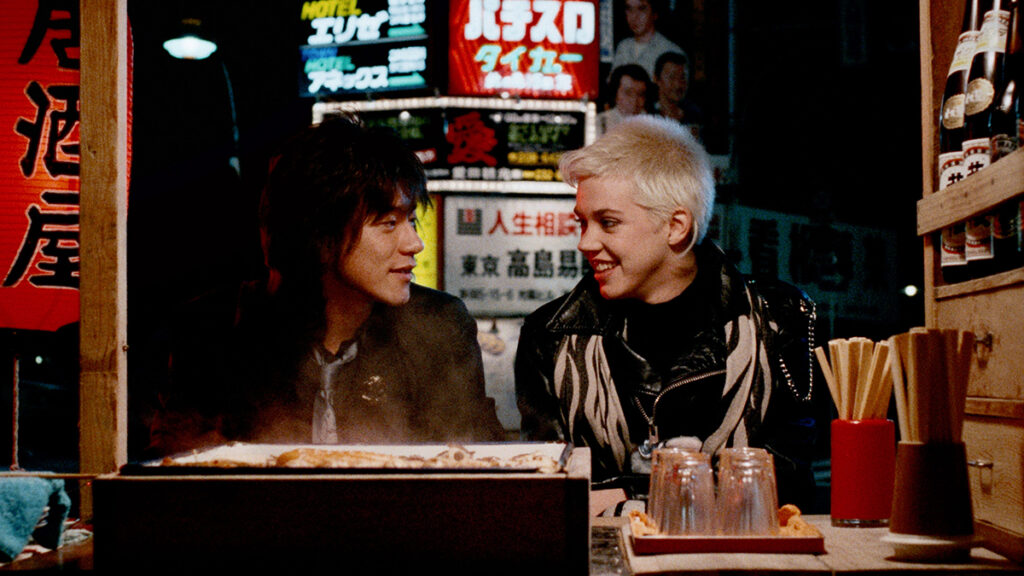
Wednesday, March 27 @ 7:30pm / NEIU
TOKYO POP
Directed by Fran Rubel Kuzui • 1988
Tired of trying to make it in America (and of her loser boyfriend), aspiring rock and roller Wendy Reed moves to Tokyo and falls in love with Hiro, an unsuccessful musician (real-life successful musician Diamond Yukai). Wendy joins Hiro’s band The Red Warriors as lead singer, and the group of under-achievers gets their first taste of success. Tokyo Pop was inspired by Kuzui’s experiences as a film distributor in Japan, where she imported films like Stop Making Sense and Wild Style. “I looked at the films made by foreigners in Japan, and they seemed either romantic or macho. I didn’t see anything that included the joys of pop culture made on the streets.” Kuzui secured financing from Canadian production company Spectrafilm with the condition that she would find a reasonably well-known lead actress to boost eventual VHS sales. The reasonably well-known actress ended up being Carol Burnett’s daughter Carrie Hamilton, perfectly cast and plucked from the TV show Fame. The resulting film is a gorgeous love letter to Japanese pop culture that also addresses the fickle nature of success. Spectrafilm went bankrupt shortly after the film was released, and the original 35mm prints and elements were scattered to the winds. Recently digitally restored with funding from none other than Dolly Parton (uncredited producer of Kuzui’s other film, Buffy the Vampire Slayer), we’re pleased to present Tokyo Pop in a rare surviving original release print from our own collection. (JA)
99 min • Kuzui Enterprises • 35mm from the Chicago Film Society collection at the University of Chicago Film Studies Center, permission Kino
Preceded by: “Juke-Bar” (Martin Barry, 1990) – 10 min – 35mm
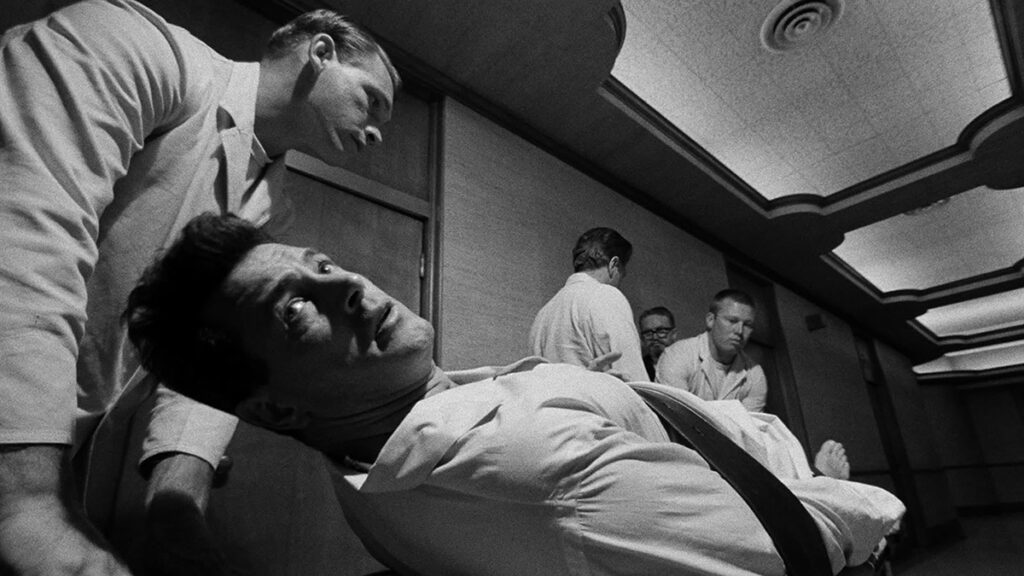
Monday, April 1st @ 7:00 / Music Box Theatre
SECONDS
Directed by John Frankenheimer • 1966
Seconds, adapted from David Ely’s 1963 novel, is not for the faint-hearted. Director John Frankenheimer, known for his work on The Manchurian Candidate and Seven Days in May, brings forth a chilling psychological horror film deeply entrenched in science fiction. Renowned cinematographer James Wong Howe’s striking visuals, which earned the film an Academy Award nomination, heighten the sense of paranoia and existential dread. Seconds revolves around Arthur Hamilton (John Randolph), a disenfranchised banker unsatisfied with his marriage and the overall course of his life. A call from a friend beyond the grave lures him into working with The Company, an agency that promises a complete life reincarnation through dark and unpleasant means. At the hands of The Company, Arthur transforms into Antiochus Wilson, a seaside painter portrayed by the iconic Rock Hudson. Arthur’s transformed physique, achieved by way of rhinoplasty, hair transplants, and months of physical training, is novel to him. But can he mentally handle the transition of leaving his old world behind? Seconds refuses to shy away from the macabre details of Arthur’s experience. The film intensifies his transformation with footage of real-life plastic surgery; director Frankenheimer stepped in as a camera operator for this scene after a crew member fainted. Rock Hudson gives a career-defining performance that serves as the film’s focal point, shedding light on the consequences of attaining a second life and realizing one’s desires. Seconds weaves together a Dionysian party, dystopian realities, and the unsettling moral complexities associated with fulfilling one’s deepest wishes. The result is a rapid fever dream of cinematic unease and excellence. (TV)
106 min • Paramount Pictures • 35mm from private collections, permission Paramount
Preceded by: “By the Sea” (Pat O’Neill, 1963) – 10 min – 16mm from Canyon Cinema
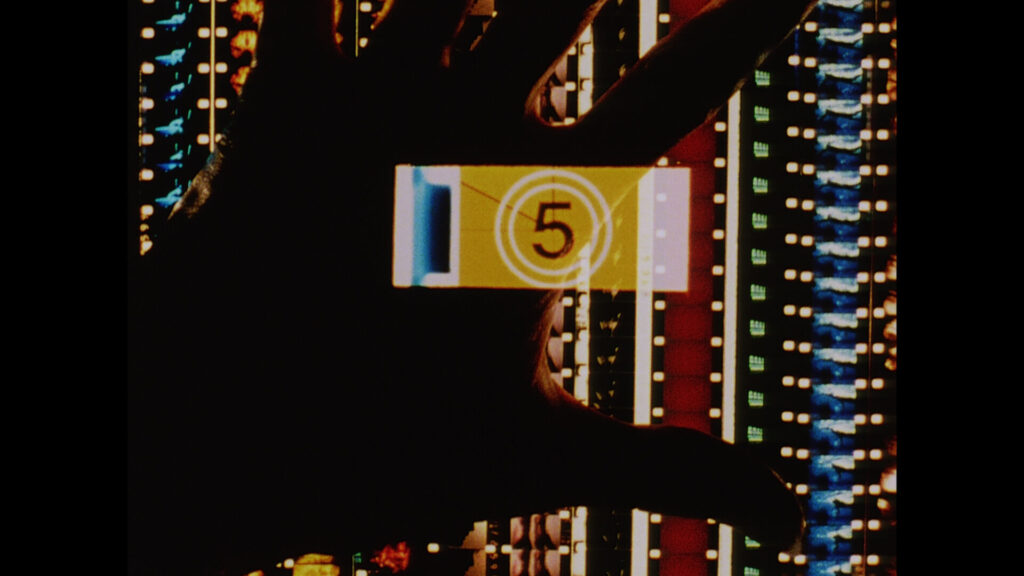
Saturday, April 6 @ 7:00 PM / Chicago Filmmakers
Left-Handed Memories: The Films of Shellie Fleming
Directed by Shellie Fleming
During the course of her time in Chicago, artist and educator Shellie Fleming touched the lives of innumerable people passing through the city’s film scene. While Fleming passed in 2013, the impressions she made can still be felt, not just in her many acolytes who have remained local (including the author of this capsule), but throughout the entire spectrum of international artist cinema, with a number of her former students considered among today’s most important and respected living filmmakers. While Shellie’s influence on the contemporary film world has been significant, it’s been exerted quietly. Her own 16mm films have screened infrequently throughout the 21st century, but their formal innovations and emotional depths have earned her a standing among connoisseurs of experimental cinema as one of the best filmmakers of the ’80s and ’90s. The films in this program prove this reputation justified, wedding optically-printed reveries with practical explications of the filmmaking process, Fleming’s own evocative writing sharing space with sounds and images appropriated from classic Hollywood cinema, coalescing into an inimitable body of work as curious, intelligent, and sensitive as the woman who made it. Included in this program are the films Left-Handed Memories (1989), Private Property (Public Domain) (1991), Ornithology (1995), and Life/Expectancy (1999). (CW)
Approx. 80 min • 16mm
Presented in partnership with the John M. Flaxman Library at the School of the Art Institute of Chicago as part of the Onion City Experimental Film & Video Festival (running April 4 – 7)

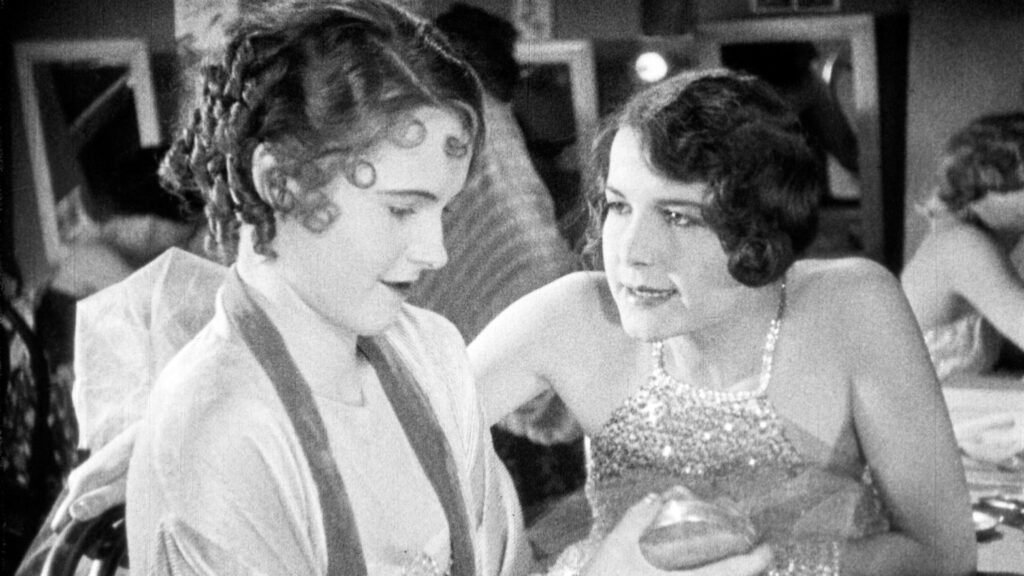
Saturday, April 13 @ 11:30 AM / Music Box Theatre
PADLOCKED
Directed by Allan Dwan • 1926
The sexual hypocrisy of the Jazz Age is skewered, throttled, and puréed in Padlocked, an upside-down morality tale about the petty tyranny of the purity brigade. Edith Gilbert (Lois Moran) just wants to be a normal teen, but her Holy Roller father Henry (Noah Beery) is too busy crusading against the modern world to be an effective parent. While Henry is off delivering a barnstormer of a speech against vice, Edith’s mother (Florence Turner) throws her a secret birthday party. Dad comes home early to find Mom blindfolded, playing Pin the Tail on the Donkey and inadvertently revealing her husband to be the biggest ass of them all. Henry announces that Edith will be sent to live with his steadier sister and then accidentally kills his wife by knocking her out and filling her bedroom with gas. After the funeral, Henry suggests that Edith should be adopted by his pious secretary, but she runs off to become a burlesque dancer instead. Edith starts spending weekends at the home of an ‘aesthetic dance’ instructor and his partner-in-crime, a woman who’s aged out of debauchery herself and grooms young ladies to join their lifestyle. A totally bonkers movie that’s simultaneously a sincerely feminist plea for emancipation and a frothy, QAnon-adjacent child-trafficking bromide from the pit of hell, Padlocked hangs together thanks to the smooth craft of director Allan Dwan and cinematographer James Wong Howe. Unseen since 1926 and recently restored from the sole surviving copy in the Národní Filmový Archiv, Padlocked must be seen to be believed. Restored by San Francisco Silent Film Festival with the support of the National Film Preservation Foundation. (KW)
80 min • Paramount Pictures • 35mm from San Francisco Silent Film Festival
Preceded by: “Flaming Flappers” [Fragment] (Fred Guiol, 1925) – 9 min – 35mm from Library of Congress
Live musical accompaniment by David Drazin!
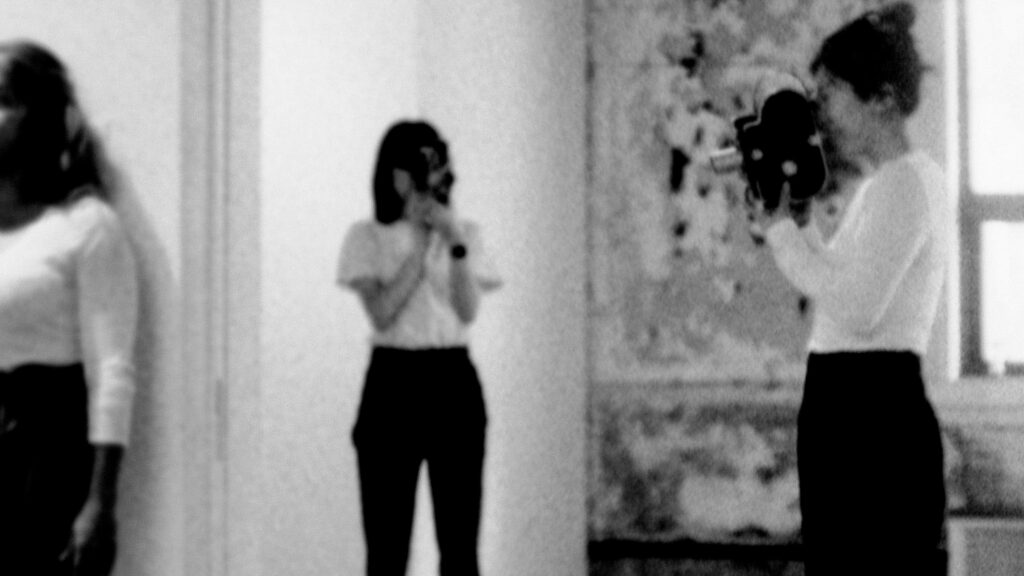
Saturday, April 20 @ 7:00 PM
Films to Dance to with Kioto Aoki
Directed by Kioto Aoki
Musician, photographer, and curator Kioto Aoki has emerged within Chicago’s art world as an irreducible and multivalent creative force. It’s a wonder, then, that she has also found the time to become one of the city’s most active and prolific filmmakers, producing dozens of short subjects in 16mm over the past ten years using 100% photochemical means. Filmed silent, often edited in camera and tied to a set of material constraints, Aoki’s 16mm work openly and proudly elicits comparisons to various classics of structuralist cinema. Enlivening these rigorously delineated film architectures is a healthy dose of artistic play, which sees her incorporating elements of dance and movement performance, treating the camera as a tool for improvisation much like a musical instrument, and retaining all technical miscalculations which may arise during filming. The results count among the most charming works offered by contemporary experimental cinema. After previously highlighting Aoki’s work as part of our Celluloid Now showcase, CFS is thrilled to present a full program’s worth of her short films, including previously unscreened work and a brand new print commissioned by CFS of her only sound film to date, Celluloid Now 2022 selection 6018 | Dance (2022). (CW)
Approx. 60 min. • 16mm from Kioto Aoki
This program will feature live musical accompaniment by Aoki’s frequent collaborator Jamie Kempkers.
This screening is supported by:

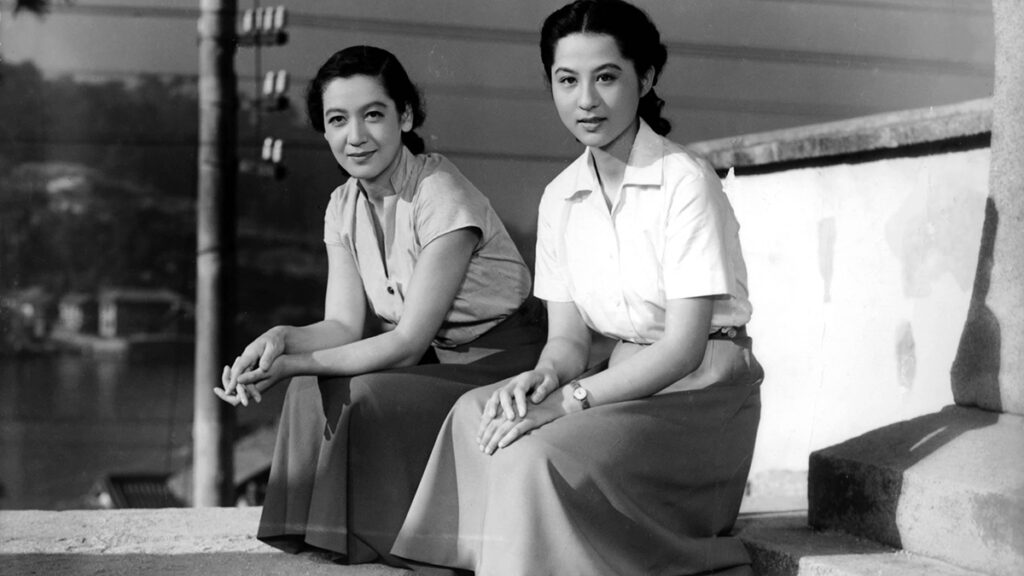
Wednesday, April 24 @ 7:30 PM / NEIU
TOKYO STORY
Directed by Yasujirō Ozu • 1953
Yasujirō Ozu’s nuanced and beautifully realized portrait of postwar life in Japan is a depiction of family, and of the consequences of belonging to one—among them joy, connection, regret, and grief. By the time of Tokyo Story‘s 1953 release, Ozu had directed 39 features and 6 shorts in a career that started in 1927. Taking inspiration from Hollywood’s 1937 drama Make Way for Tomorrow, an intergenerational family story set in the aftermath of the Great Depression, he set out to make Tokyo Story. Despite Ozu’s assertion that it’s his most melodramatic feature, it is a perfect introduction to his distinctive visual style and his narrative preoccupations. Through his signature cutaways, he depicts the modernization and Westernization of Tokyo. Like many of his other movies, it is also a domestic drama (although the director remained famously unmarried). The grandparents, Tomi (Chieko Higashiyama) and Shukichi (frequent Ozu collaborator Chishū Ryū) aren’t perfect; we meet Shukichi as an amiable elder, not as a compulsive drinker. The children carry pain too. The movie’s lone hero is their widowed daughter-in-law (Ozu regular Setsuko Hara), a character already painfully acquainted with loss. If only being a part of a family was simple. Tokyo Story does not condemn the offspring (although their selfish dismissiveness does rattle). If anything, it takes great pains to show one of the causes of this fissure. They are not deliberately cruel. It contributes to the movie’s potent universality. They are busy. They are distracted. The world had changed. As Tokyo transforms, so does the family over three generations. (RIN)
136 min • Shochiku • 35mm from Janus Films
Preceded by: Harry and Tonto trailer (1974) – 35mm
Programmed and Projected by Julian Antos, Becca Hall, Rocío Irizarry Nuñez, Rebecca Lyon, Tavi Veraldi, Kyle Westphal, and Cameron Worden.
Research Associate: Mike Quintero
The Chicago Film Society is partially supported by a grant from the Illinois Arts Council Agency and partially supported by a CityArts Grant from the City of Chicago Department of Cultural Affairs & Special Events.
Heartfelt thanks to:
Shayne Pepper, Cyndi Moran, Robert Ritsema, Jose Aguinaga of Northeastern Illinois University; Brian Andreotti & Ryan Oestreich of the Music Box Theatre; David Antos; Brian Belovarac of Janus Films; Bret Berg of the American Genre Film Archive; Keero Birla of White Mountain Films; James Bond of Full Aperture Systems; Chris Chouinard of Park Circus; Peter Conheim; Amy Crismer of Disney; Justin Dennis of Kinora; Carolyn Faber; Rebecca Fons of the Gene Siskel Film Center; Harry Guerro; Jason Jackowski of Universal Pictures; Matt Jones of UNCSA Moving Image Archives; Steven Lloyd; Douglas McLaren of the University of Chicago Film Studies Center; Jeff Milam of Ecometric Solutions; Brett Kashmere & Seth Mitter of Canyon Cinema; Tim Morefield; Nicky Ni of Onion City Experimental Film & Video Festival; Kathy Rose O’Regan & Rob Byrne of San Francisco Silent Film Festival; Beth Rennie, Jared Case, & Jeffrey Stoiber of George Eastman Museum; George Schmalz of Kino Lorber; Lynanne Schweighofer, Andy Whitmore, & David Pierce of the Library of Congress; Leila Sherbini of Chicago Filmmakers; Tommy José Stathes; Patricia Ledesma Villon of Walker Art Center; Gabriel Wallace; and Todd Wiener & Steven Hill of UCLA Film & Television Archives. Particular thanks to CFS research associate Mike Quintero, CFS board members Raul Benitez, Mimi Brody, Edo Choi, Steven Lucy, Brigid Maniates, & Artemis Willis, & CFS advisory board members Brian Block, Lori Felker, and Andy Uhrich.
And extra special thanks to our audience, who make it all possible!

